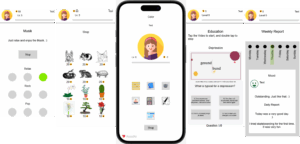Development of a game-based information tool to help adolescents with depression to structure their daily lives
Aim and Research Question(s)
This thesis aimed to design and evaluated a gamified prototype that helps adolescents with depression build daily routines
- RQ#1: 'What is the assessment of experts regarding the potential impact of digital playful approaches to establishing or maintaining a daily routine in adolescents with depression?'
- RQ#2: 'How do experts assess the practicality and effectiveness of the developed digital tool for daily routine structuring in adolescents with depression, with regard to motivation, user engagement, and potential long-term use?'
Background
Nearly half of mental disorders emerge before age 18, with an average onset at 14.5 years [1]. Globally, 10–20% of adolescents experience mental health problems, with depression being one of the most common [2]. In adolescents, depression often leads to low motivation, social withdrawal, and self-harm, severely impairing daily life. Mental disorders are a leading cause of disability and reduced quality of life, especially among young women [3].
Methods
The study used semi-structured interviews with six child and adolescent psychiatry professionals to explore the perceived effectiveness of a gamified digital tool for supporting routines in depressed adolescents. Findings informed prototype development, later evaluated by the same experts via a structured questionnaire.
Results and Discussion
RQ#1: Experts view gamification as a beneficial addition to therapy that enhances motivation, adherence, engagement, and self-efficacy when designed sensitively and in accordance with Self-Determination Theory (SDT), without competitive elements such as leaderboards, and with supportive feedback.
RQ#2: The prototype evaluation was positive overall (mean 4/5), with high scores for therapeutic benefit (4.5) and self-efficacy (4.3), as well as good scores for motivation and psychosocial aspects (both 4.0). There is room for improvement, particularly regarding the user interface and willingness to recommend (both 3.5).

Conclusion
The prototype demonstrates promise in supporting adolescents with depression by combining gamification with therapeutic principles, offering a motivating way to build positive daily routines. However, it should be seen only as a complement to professional care, with further development and user-centred research needed to refine its design, ensure usability, and validate its long-term effectiveness.
References
[1] M. Solmi u. a., „Age at onset of mental disorders worldwide: large-scale meta-analysis of 192 epidemiological studies“, Mol. Psychiatry, Bd. 27, Nr. 1, S. 281–295, Jan. 2022, doi: 10.1038/s41380-021-01161-7. [2] World Health Organization, „Depressive disorder (depression)“. Zugegriffen: 28. November 2024. [Online]. Verfügbar unter: https://www.who.int/news-room/fact-sheets/detail/depression [3] S. Naab, M. Hauer, U. Voderholzer, und M. Hautzinger, „Depressive Störungen bei Jugendlichen: Diagnostik und Therapie“, PSYCH Up2date, Bd. 8, Nr. 01, S. 49–64, Jan. 2014, doi: 10.1055/s-0033-1359935.
